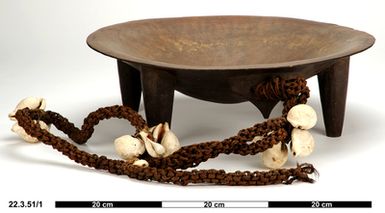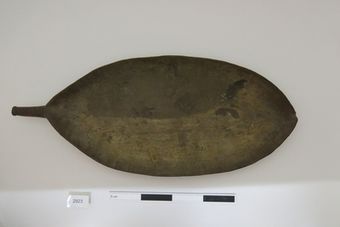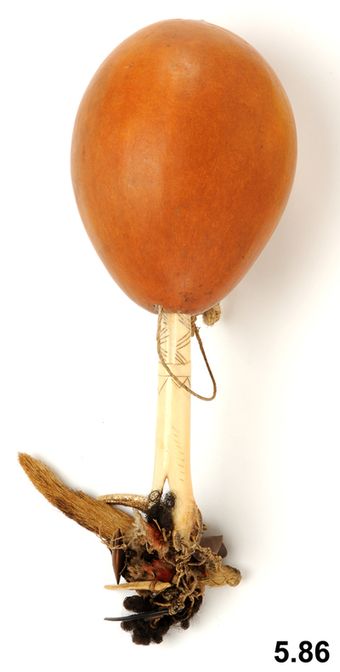Connect with Horniman Museum and Gardens
Contact this content partner to get more information about this item.
kava bowl (bowl (narcotics & intoxicants: drinking))
- Description:
- Kava Bowl, Tanoa, Fiji, Western Polynesia. Extremely large wooden bowls for the communal drinking of yaqona (kava) are among the most significant pieces of wood sculpture produced in Western Polynesia. Kava, the powdered root of the pepper plant (Piper methysticum) is a non-addictive, mild stimulant made up with cold water as an infusion and suspension, which is drunk throughout the Pacific. For men in particular, it forms a central focus of social life in Western Polynesia. Kava-drinking originally had a religious function in Fiji, where traditional priests (bete) drank it to enter possession trances. In neighbouring Tonga, however, it was an important part of chiefly coronations, and also drunk socially. When Tongan culture began to strongly influence Fijian culture in the later 18th Century, social kava drinking was one of their main gifts to the Fijians. This bowl follows the classic style of tanoa shared between Fiji and Tonga: it is four-footed with a smooth and sinuous curve inside and out. It is cut from a single block of hard, heavy, red vesi wood (Intsia bijuga) and, at 62 cm in diameter, can only have come from a substantial, mature specimen. This bowl comes complete with a large watabu chain-rope of plaited coconut fibre cord attached to its suspension lug (taunga), bearing ten large, fine egg cowrie shells (buli, Ovula ovum). This watabu was laid out in the Tongan style during formal drinking, and indicated both the highest-ranking person present, and the axis of the kava circle. Hardwood, coconut fibre, shell. Probably Mid-19th Century. Formerly in the private collection of Mrs Elaine Davies. Four-legged kava bowl, vesi (Intsia bijuga) wood with sinnet rope, and ten large Egg cowrie shells attached, two of which are broken.
- Format:
- image
- Collections:
- Horniman Museum and Gardens
- Content partner:
- Horniman Museum and Gardens
- Availability:
- Not specified
-
Copyright status: All rights reservedFind out more about what you are able to do with this itemThis item is all rights reserved, with means you'll have to get permission from Horniman Museum and Gardens before using it. For more information, please see our use and reuse page.More informationHorniman Museum and Gardens has this to say about the rights status of this item:
http://rightsstatements.org/vocab/InC/1.0/
What can I do with this item?Non-infringing useNZ copyright law does not prevent every use of a copyright work, and this item may be hosted by an international institute or organisation. You should consider what you can and cannot do with a copyright work.No sharingYou may not copy and/or share this item with others without further permission. This includes posting it on your blog, using it in a presentation, or any other public use.No modifyingYou are not allowed to adapt or remix this item into any other works.No commercial useYou may not use this item commercially.
Related items
Welcome and warm Pasifik greetings
The information on this site has been gathered from our content partners.
The names, terms, and labels that we present on the site may contain images or voices of deceased persons and may also reflect the bias, norms, and perspective of the period of time in which they were created. We accept that these may not be appropriate today.
If you have any concerns or questions about an item, please contact us.



